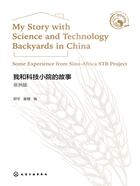
Arriving at China Agricultural University and experiencing the early life in Beijing
I left the airport in a taxi, meaning in that car there were only two human beings. By the way, we could not have a conversation because of the language barrier. It was then that I thought of checking my cellphone. Wonders never cease to happen. My phone battery had died, and there I was again, stuck in the middle of a new unknown place. I could not let this ruin my moment though, so I decided to look outside my window. What I saw that day was still beyond every word I can use to explain. To begin with, I never imagined people could make things like that so real. China has beautiful roads, bridges, and railway networks. I can not estimate how much time they took to put this into reality, but my wild guess is that this work came from a whole dedicated generation with infinite love for their country.
From the ground up into the skies, all I could see were tall buildings, taller than what I had seen in my country or any neighboring one for that matter. The height is not where the point is, but the fact that most of these buildings are for people to live in! Back at home, we know such developments to be done for businesses, offices, or banks, but here, people live in skyscrapers. Everything is so different, with my experience of each family owning their piece of land and individual house. I had so many questions in my mind how the Chinese got to that stage where they live peacefully in such structures without anyone fighting for individual ownership.
I passed several tollgates, and I noticed that the driver was not using cash to pay for the toll fee. If we had been talking I would have asked, but then I realized that the system is completely automated. Once a car approaches the tollgate, its number is scanned and money is deducted. It began to dawn on me that I had just arrived in an almost cashless society. If someone had cash on them, it would only to be me and a few newcomers. We arrived at China Agricultural University just as the sun began to set. One can just imagine how complicated I thought life was going to be then. Luckily, the university is always alight at night. Electricity never goes out, so the difference between day and night is just barely noticeable. I took out my campus map and started walking down towards the International Students Building. When I arrived, I approached the receptionists and gave them my paperwork. I was the first student from Africa to come for this Science and Technology Backyard. To them, it was pretty straightforward to deal with. We had a few things to settle before they then allowed me to spend the night in what later became my permanent room to this day.
The following morning, I was visited by experts from the department, including Professor Jiao. I was happy to get to meet the people I was here for. A few days passed by and my African colleagues started coming in. We helped each other with the processes such as getting mobile lines, banking, and medical checks. We got to know each other, and to me, it was a happy moment knowing that at least I had people I share something in common with. I then started looking for any colleagues from my country. After some time I got two of them and for the first time, I could speak my local language. That was very important to me, given all the experiences that I had gone through.
After several days of meetings, registrations, and familiarizing myself with the new place, we got along well together. I began to understand the nature of my program with the help from the project assistant Jiangshan. During those days, we also registered with the Department of Exit and Entry before our visas expired. With all these things going on, I had a new experience of using electronic money. Unlike at home where I used several applications for social media, here I began to use WeChat. All the transactions are done on it, while some people prefer to use Alipay. I found WeChat to be a powerful application.
I learned a lot from how convenient online buying was:the availability of raw materials that I could use to make our staple food“Sadza”with either beans, beef, or pork, and a lot of vegetables like tomatoes, cabbage, carrots, etc. While I was doing that, I also learned how to eat with chopsticks. It was such a fascinating experience, given the fact that in my country we normally go naturally with our bare hands. Here and there on special occasions, we make use of forks and knives, but it is rather an imported culture. To this day, I can eat with chopsticks, without any difficulty—what an exciting accomplishment!